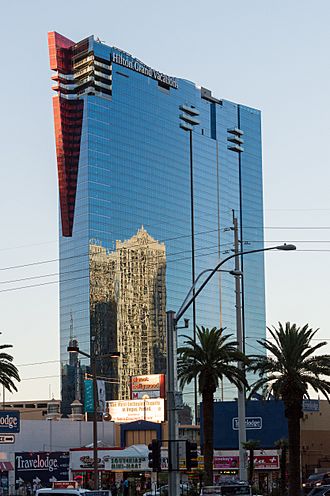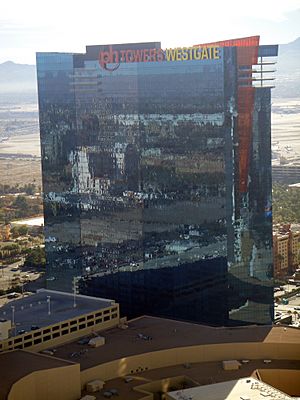Elara (timeshare) facts for kids
Quick facts for kids Elara |
|
|---|---|
 |
|
| Former names | PH Towers |
| General information | |
| Status | Complete |
| Type | timeshare |
| Address | 80 East Harmon Avenue |
| Town or city | Paradise, Nevada |
| Country | United States |
| Coordinates | 36°6′30.65″N 115°10′7.75″W / 36.1085139°N 115.1688194°W |
| Groundbreaking | January 19, 2006 |
| Topped-out | July 2, 2008 |
| Opened | December 18, 2009 |
| Cost | $660 million |
| Owner | LV Tower 52 LLC |
| Management | Hilton Grand Vacations Company |
| Technical details | |
| Floor count | 52 |
| Design and construction | |
| Architect | Gerald Koi |
| Developer | Westgate Resorts |
| Other designers | DiLeonardo International (interior) |
| Main contractor | Tutor-Saliba Corporation |
| Other information | |
| Number of units | 1,201 |
Elara is a tall building in Paradise, Nevada. It used to be called PH Towers. It has 52 floors and is located right behind the Planet Hollywood resort on the famous Las Vegas Strip.
Elara is a timeshare building. This means many different people own parts of it for specific times of the year. It also has hotel rooms for guests visiting the Planet Hollywood resort.
The idea for this building started in 2005. Two people, Robert Earl and David A. Siegel, worked together to make it happen. Construction began in January 2006. The building was finished, or "topped off," in July 2008. It cost about $660 million to build. Elara officially opened its doors in December 2009. There were plans for more towers, but they were never built.
When it first opened, the tower had 1,201 rooms. About 200 of these were for timeshare owners. The rest were used as hotel rooms for the Planet Hollywood resort. The building's ownership and management changed a few times. In 2011, Hilton Grand Vacations Company took over. They renamed the building Elara in March 2012.
Contents
Building Elara: From Idea to Reality
Early Plans for the Land
Before Elara was built, there were other ideas for the land. In the late 1990s, a company called Aladdin Gaming wanted to build a music-themed resort there. This project was planned with Planet Hollywood International, Inc. However, the partnership ended because of money concerns.
Later, in 2000, Aladdin Gaming thought about building a hotel and condo tower. This project would have been connected to their Aladdin resort. A company from New York, The Athena Group, planned to buy the land. They wanted to build a 35- to 40-story building with hotel rooms and condos. But by 2001, these plans were also cancelled. The Aladdin resort was having financial problems.
Robert Earl, who started Planet Hollywood International Inc., bought the Aladdin resort in 2003. He lived near David A. Siegel, who founded Westgate Resorts. They had talked about building a timeshare in Las Vegas since 2000. After Robert Earl bought the Aladdin, their talks became serious.
In April 2005, Westgate Resorts announced their plan. They would build a 52-story timeshare tower. It would cost $400 million. Westgate would pay for it, and Starwood would manage it. Construction was set to begin later that year. The first units were expected to be ready by New Year's Eve 2007. Any timeshare units that weren't sold would be used as hotel rooms. The Aladdin resort was also going to be updated and renamed Planet Hollywood.
Construction Begins
The official start of construction for the Planet Hollywood Towers was on January 19, 2006. This event is called a groundbreaking. At this point, the project was expected to cost $750 million. Gerald Koi designed the building. DiLeonardo International created the inside designs. Tutor-Saliba Corporation was the main builder. The tower eventually became known as PH Towers.
The building was "topped off" on July 2, 2008. This means the highest point of the building was reached. Famous people like actor Sylvester Stallone and Nevada governor Jim Gibbons attended a ceremony. The tower was originally supposed to open in August 2009. By July 2009, Planet Hollywood started hiring 800 people for the new tower. It had a "soft opening" in October, meaning it opened quietly. The official grand opening was planned for a month later.
By late September 2009, the opening was set for December. The first tower ended up costing $660 million. Plans for two more towers were cancelled.
Opening and New Name
The first people moved into the tower on December 18, 2009. This was part of its soft opening. Hotel guests started staying there on December 28. An official opening was planned for January 2010. The tower was promoted as the largest timeshare building in the world. Its sign on top had the biggest letters on the Las Vegas Strip. It was also the first timeshare connected to a major casino resort.
The tower had 1,201 rooms and 28 fancy penthouses. Westgate Resorts owned it. Planet Hollywood helped with marketing and running the building. About 200 rooms were for timeshare owners. The rest were hotel rooms for the Planet Hollywood resort.
The Planet Hollywood resort was sold to Harrah's Entertainment. This company then took over marketing and running PH Towers. Westgate Resorts faced money problems because of the Great Recession. Banks were not giving loans for sales at the tower. In November 2011, a company called Resort Finance America LLC took control. They asked Hilton Grand Vacations Company to rebrand the tower. Hilton would also handle sales and marketing for vacation ownership. More than 12,000 timeshare owners were not affected by this change.
The tower was then sold to LV Tower 52 LLC. On March 1, 2012, the property got its new name: "Elara, a Hilton Grand Vacations Club." The tower was even shown in a 2012 movie called The Queen of Versailles. By 2017, it was known as "Elara by Hilton Grand Vacations."
Construction Lawsuit
After the tower was built, the main builder, Tutor-Saliba Corporation, filed a lawsuit in May 2010. They said Westgate Resorts owed them $19.3 million for building the tower. Mark Waltrip, who was in charge of Westgate Resorts, disagreed. He said Tutor-Saliba actually owed Westgate Resorts $18 million. This was for things like overcharges and work that wasn't done correctly.
The court case started in October 2012. In 2013, the court decided that Westgate Resorts did owe Tutor-Saliba $19.3 million. Westgate Resorts appealed this decision. But in May 2017, the Nevada Supreme Court agreed with the first decision. Tutor-Saliba won the case.



